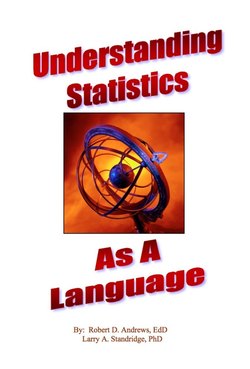Читать книгу Understanding Statistics As A Language - Robert Andrews - Страница 13
На сайте Литреса книга снята с продажи.
Ratio Scale
ОглавлениеA ratio measurement scale is very much like an interval measurement scale except the observations have an absolute zero. Dollars or cents, yards or feet, minutes or seconds and cash on hand are all ratio measurements or measurements on a ratio scale. Practically speaking, ratio data are equivalent to interval data and may be analyzed by many of the same statistical methods.
Hypothesis Testing
In the behavioral sciences, research is conducted to determine the acceptability of hypotheses derived from theories of behavior. The researcher develops a hypothesis from a theory and collects empirical data to determine the acceptability of the hypothesis. The empirical data may lead to retaining, revising or rejecting the hypothesis and/or the theory from which the hypothesis was developed. (Siegel 1956)
Definition: A research hypothesis is a statement of theory, previous research results, or other information that leads to an anticipated outcome.
Definition: A null hypothesis is a hypothesis of no difference. According to the null hypothesis, any observed difference between samples is regarded as a chance occurrence resulting from sampling error alone. If the null hypothesis of no difference is rejected, the alternate hypothesis that a true population or sample difference does exist is accepted.
Definition: An alternative hypothesis is a claim about a population parameter that will be true if the null hypothesis is false.
In order to make an objective decision about whether or not a particular hypothesis is confirmed by a set of data, objective procedures are needed. Following are a set of procedures [The procedures were adapted from Siegel (1956). The definitions related to hypothesis testing were adapted from Siegel (1956 ), Mann (1992) and Elmore et al. (1997)], in order of performance that can be used to determine the disposition of a null hypothesis: (1) state the null hypothesis (Ho), (2) choose a statistical test for testing Ho [See the Decision Model], (3) specify a significance level () and a sample size (n), (4) find / assume the sampling distribution of the statistical test under Ho, (5) define the region of rejection, and(6) compute the value of the statistical test, using the data obtained from the sample(s). If the computed value is in the region of rejection, reject Ho. If the computed value is outside the region of rejection, Ho cannot be rejected at the chosen level of significance.
Definition: Significance level of a test is the probability of rejecting Ho when in fact it is true. The size of the rejection region depends on the value assigned to . The commonly used values of are 0.01, 0.05, and 0.10. In social science research, the most common value of is 0.05.
Definition: The critical value or critical point is the place on a curve at which the rejection and nonrejection regions are divided.
Decision Model
The Decision Model is a chart designed to facilitate a decision about which statistical procedure is most appropriate in the analysis of a set of data. (See Figure 1) A few questions about a set of data can lead quickly to a decision about which statistical procedure is most appropriate. The questions are: (1)
What type of measurement scale produced the data -- nominal, ordinal, or interval/ratio scale? (2) Were the data related or independent? Was there an absence of association between observations or were the observations related as in a pretest/posttest of the same group? (3) How many groups were measured? (4) How many measurements were involved? By answering these questions and following the Decision Model downward, the appropriate statistical procedure can be identified.
The Matrix view of the Decision Model provides another quick reference in determining the appropriate procedure. (See Table 2) The variables are in the left column; the procedures of choice according to the measurement scale are in the other three columns.
Table 2: Matrix View of the Decision Model
| Groups/Measures | Nominal | Ordinal | Interval/Ratio |
| 1 Group/ 1 Measure | Descriptive / Detailed One Variable | Descriptive / Detailed One Variable | |
| Independent Data 2 Groups/ 1 Measure >2 Groups/1 Measure | Mann-Whitney U Kruskal-Wallis | Independent Group t-Test One Way ANOVA | |
| Related Data 1 Group/2 Measures (Relation) 1 Group/2 Measures (Gain/Loss) 1 Group/>2 Measures | Spearman Rank Wilcoxon Signed Rank Friedman | Pearson Product Moment (Fisher t-Test) Paired t-Test | |
| 1 Group(% Data)/ 1 Group (Raw Data) 2 or >2 Groups Test of Independence | X2 Goodness of Fit X2 Test of Independence | ||
| Conditions: 1. Data is in categories and category frequencies are analyzed. | Conditions: 1. Data is ranked and ranks are analyzed. | Conditions: 1. Assume random sample 2. Assume normal curve |
